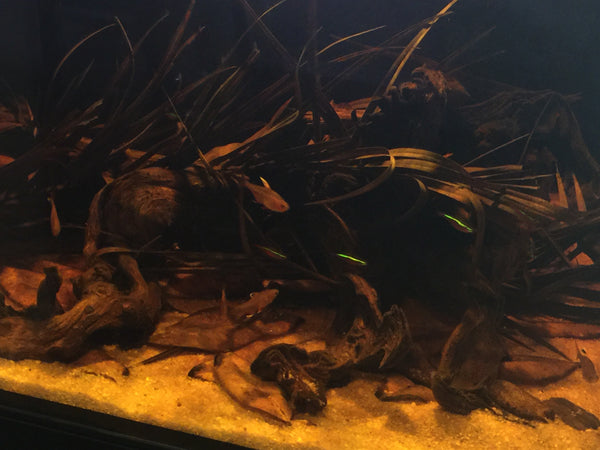- Continue Shopping
- Your Cart is Empty
The fine art of "leaving well enough...alone"
We talk a lot about patience here, especially in the context of working with our botanical-style blackwater aquariums. We've pretty much force-fed you the philosophy of not rushing the evolution of your aquarium, of hanging on during the initial breakdown of the botanicals, enjoying the random nature of leaves...not freaking out when the biofilms appear...you know- patience.
Embracing the process.
What goes hand-in-hand with patience in aquarium keeping is the concept of...well, how do I put it eloquently...leaving "well enough alone"- not messing with stuff.
Yeah, just not intervening in your aquarium when no intervention is really necessary. I mean, sure, it's important to take action in your aquarium when something looks like it's about to "go South", as they say- but the reality is that good things in an aquarium happen slowly, and if things seem to be moving on positive arc, you need not "prod" them any further.

I think this is one of the most underrated mindsets we can take as aquarium hobbyists. Now, mind you- I'm not telling you to take a laissez-faire attitude about managing your aquariums. However, what I am suggesting is that pausing to contemplate what will happen if you intervene is sometimes more beneficial than just "jumping in" and taking some action without considering the long-term implications of it. It's one thing to be "decisive"- quite another to be "overreactive!"
When that fish starts hiding in the corner, one of the first words out of our mouths is "disease!" Well, IS that what's happening, or is the fish merely "chilling out", or perhaps startled, or even- guarding a clutch of eggs? Your first action shouldn't be to net the fish out, tearing up the aquascape and generally freaking out every fish in the process, right? I mean, consider what could have precipitated the behavior before springing into an action that might have worse consequences for your aquarium and the inhabitants. Maybe it's literally just a "passing behavior" for the fish. Like any living creature, fishes will occasionally engage in unexpected behaviors, which are not necessarily indicative of an illness or problem.

How do you know what to do- or if you should do something? You observe. It's what you already do a lot of anyways, right? Observe your tank constantly, which will give you a sort of "baseline" for it's normal function, for the fishes' behaviors, the operational "norms" of the equipment, the environmental parameters, etc. Just because a blog or a book or a friend tells you that "x" is "not right" doesn't necessarily mean that it isn't in your aquarium. Sure, if you have ammonia, something is not right. Duh. However, if the otherwise healthy Cryptocoryne is growing more slowly in your tank than what "the books" say, it may not be a "problem", right? There could be a lot of different reasons- many of which are not remotely associated with "problems." The key to understanding when stuff is going wrong is to know what it's like when things are going right in your tank. Observe. Constantly.
Document your tank and it's operation. Keep a notebook, take pics, whatever it takes. One of the things we love to see are the tank "progression pics" that you share with us on Facebook. You can see how the botanicals begin to break down, how the water "tints", how the fish color up, etc. It's part of the observation process, which is part of the understanding process, which is part of how you determine if you need to leave stuff alone, or spring into decisive action to circumvent a potential disaster!
It's that simple. You probably already do this to some extent. However, it's easy to forget when its "your babies", right? Online aquarium forums are filled with frantic questions from members about any number of "problems" happening in their aquariums, a good percentage of which are nothing to worry about. You see many of these hobbyists describe "adding 100 mg of _______ the next day, but nothing changed..." (probably because nothing was wrong in the first place!). Now, sure, sometimes there ARE significant problems that we freak out about, and should jump on-but we have to "pick our battles", don't we? Otherwise, every time we see something slightly different in our tank we'd be reaching for the medication, the net, adding another gadget (a total reefer move, BTW), etc.
Let nature take its course on some things.
Yup.
For example, you have biofilms appearing on your botanicals. Understand what they actually are, and why they appear, and that they are normal- and suddenly, those yucky-looking strands of goo don't seem quite so menacing. When you see pics from the Amazon showing biofilms and algae growth all over the place, you start to understand that, just like the brown water and decomposing leaves, they're an important, integral, and totally normal part of the habitat we replicate. Learn what "normal" is.

Realize that nature will plot a course with minimal intervention on your part. Sure, when long-term health or even the enjoyment of your system is tarnished by some of these things, intervention is necessary. Excessive algae, for example, is indicative of a an excess nutrient issue, and can be managed with simple adjustments. However, for so many things, the best "course of action" is to let nature do as she's done for eons...
Embrace nature. Understand how our closed systems are still little "microcosms", subject to the rules laid down by the Universe. Realize that sometimes- more often than you might think- it's a good idea to "leave well enough alone!"
Stay kind to yourself. Stay thoughtful. Stay observant. Stay patient...
And Stay Wet.
Scott Fellman
Tannin Aquatics
1 Response
Tyree
Good article












Scott Fellman
Author